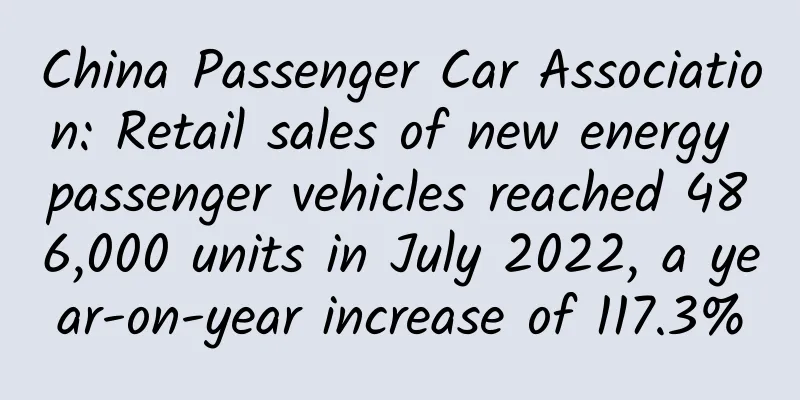China Passenger Car Association: Retail sales of new energy passenger vehicles reached 486,000 units in July 2022, a year-on-year increase of 117.3%

|
Retail: In July 2022, the retail sales of passenger cars reached 1.818 million units, a year-on-year increase of 20.4%, the second highest growth rate in the past 10 years; in July, the retail sales fell by 6.5% month-on-month, and the month-on-month growth rate was the third highest in the past 10 years. From January to July, the cumulative retail sales reached 11.079 million units, a year-on-year decrease of 3.5%, a year-on-year decrease of 410,000 units, of which the year-on-year increase of 680,000 units from June to July contributed the most. 1. Review of the national passenger car market in July In July, the spread of the COVID-19 epidemic across the country was effectively curbed. In July, 23 provinces across the country reported 2,584 confirmed cases, a slight increase from 836 cases in June. The continued improvement in logistics and supply chains after the epidemic in April, the resilience of exports, the resumption of work in the industry, and the superposition of positive policies have effectively promoted the growth of the auto market. The entry of customers into 4S stores and transactions at dealers in various places have basically returned to normal. In July, national passenger car retail sales increased by 20.4% year-on-year, basically the same as the growth rate of 23% in June, and the preferential policies and measures on vehicle purchase tax have gradually shown results. The production capacity and demand that were delayed due to the epidemic in April and May will continue to be released in June and July. The promotion efforts in the auto market remained high in July, and mainstream automakers have intensified their preferential activities, striving to make up for the sales losses caused by the epidemic in the early stage and recover the expected annual targets. In July, the retail sales of luxury cars reached 220,000 units, up 14% year-on-year and down 28% month-on-month. In the early stage, the main sales areas of luxury cars, such as Beijing and Shanghai, were greatly affected by the changes in the epidemic prevention and control situation, but have improved significantly recently. In July, domestic brands sold 850,000 vehicles, up 34% year-on-year and 4% month-on-month. In July, the domestic retail share of domestic brands was 47.4%, up 4.8 percentage points year-on-year; the cumulative share from January to July was 47.0%, an increase of 8.9 percentage points from the same period in 2021. In July, the wholesale market share of domestic brands was 49.8%, an increase of 3.4 percentage points from the same period last year; the cumulative share of domestic brands from January to July was 48.0%, an increase of 5.9 percentage points from the same period in 2021. Domestic brands have achieved significant growth in the new energy market, and leading companies have performed well. The brand share of traditional automakers such as BYD Auto, Geely Auto, Changan Automobile and Chery Automobile has increased significantly. The production and sales growth of Shanghai auto companies is strong, reflecting the continued outstanding effect of stabilizing work and resuming production in the industry. In July, mainstream joint venture brands sold 740,000 vehicles, up 10% year-on-year and down 9% month-on-month. In July, the retail share of German brands was 21.6%, up 0.5 percentage points year-on-year, and the retail share of Japanese brands was 20.8%, down 2.1 percentage points year-on-year. The market share of American brands reached 7.0%, down 2 percentage points year-on-year. Exports: In July, the export of passenger cars (including complete vehicles and CKD) under the statistical caliber of the China Passenger Car Association reached 226,000 units, a year-on-year increase of 76% and a month-on-month increase of 19%. In July, new energy vehicles accounted for 21.8% of the total exports. In July, the export of domestic brands reached 172,000 units, a year-on-year increase of 86%; the export of joint ventures and luxury brands reached 55,000 units, a year-on-year increase of 32%. Production: In July, passenger car production was 2.158 million units, a year-on-year increase of 41.6% and a month-on-month decrease of 2.2%. The supply guarantee measures of the industrial chain have taken effect. Among them, the production of luxury brands increased by 19% year-on-year and decreased by 15.0% month-on-month; the production of joint venture brands increased by 39.0% year-on-year and decreased by 6% month-on-month; the production of independent brands increased by 51.0% year-on-year and increased by 5% month-on-month. From January to July, the production of automobile companies reached 12.386 million units, a year-on-year increase of 11.8%. The shortage of imported parts affected by the epidemic has improved, and domestic parts system suppliers in the Yangtze River Delta region have gradually resumed basic supply, promoting the rapid recovery of production across the country in July. Shanghai is the hub of the national automobile industry, and its position still needs to be further strengthened. The recent supply guarantee and resumption of production have been good. The production of Changchun and Shanghai has increased significantly under the supply guarantee policy of the industrial chain. Wholesale: In July, the wholesale sales of manufacturers reached 2.134 million vehicles, a year-on-year increase of 40.8% and a month-on-month decrease of 2.5%. Driven by the new energy market, the performance of some automakers was obviously differentiated. From January to July, the wholesale sales of manufacturers reached 12.306 million vehicles, a year-on-year increase of 8.4%. Production and sales in July improved significantly month-on-month, resulting in a driving production and sales trend in which manufacturers' output was 24,000 vehicles higher than wholesale, and manufacturers' domestic wholesale was 316,000 vehicles higher than retail. The growth in manufacturers' wholesale from May to July laid the foundation for strong retail growth at the end of the year. Inventory: Since the fourth quarter of 2021, manufacturers' inventories have been replenished rapidly, with a cumulative replenishment of nearly 80,000 from January to July 2022, of which the inventory replenishment from May to July was stable. Since the purchase tax halving policy was implemented in June, the incremental contribution of manufacturers' inventory has been relatively large since May. In July, manufacturers' inventories increased by 20,000 vehicles month-on-month, and increased by 80,000 vehicles from January to July. From January to July 2021, manufacturers' inventories decreased by 260,000 vehicles. This year's manufacturers' inventories have improved significantly. In July, channel inventory increased by 90,000 vehicles month-on-month, and from January to July, channel inventory increased by 130,000 vehicles, which is in sharp contrast to the decrease of 850,000 vehicles from January to July 2021. The global epidemic has caused severe shortages, and it is a rare achievement for China's auto market inventory to recover to a medium-to-high level, laying a stable foundation for exports and domestic sales. As inventory is guaranteed, terminal retail sales in early July have significantly strengthened under policy promotion, and dealer inventory has been converted into retail growth. New energy: In July, the wholesale sales of new energy passenger vehicles reached 564,000 units, a year-on-year increase of 123.7% and a month-on-month decrease of 1.1%. Under the policy of halving the vehicle purchase tax, new energy vehicles were not only not affected, but also improved more than expected from the previous month. From January to July, the wholesale sales of new energy passenger vehicles reached 3.03 million units, a year-on-year increase of 123.0%. In July, the retail sales of new energy passenger vehicles reached 486,000 units, a year-on-year increase of 117.3% and a month-on-month decrease of 8.5%, forming a "W-shaped" trend from January to July. From January to July, the domestic retail sales of new energy passenger vehicles reached 2.733 million units, a year-on-year increase of 121.5%. In the new energy vehicle market, the supply improvement and the expectation of oil price increase have brought about a hot market. The oil price has risen while the electricity price has been locked, which has led to a hot performance in electric vehicle orders. The month-on-month trends of new energy vehicles and traditional fuel vehicles in July were significantly driven by policies. The policies to encourage consumption introduced by various regions are strong, and the full customer orders have changed the off-season pattern, further driving the hot car market in July. 1) Wholesale: The wholesale penetration rate of new energy vehicle manufacturers was 26.4% in July, an increase of 9.8 percentage points from the penetration rate of 16.6% in July 2021. In July, the penetration rate of new energy vehicles of independent brands was 45.9%; the penetration rate of new energy vehicles in luxury cars was 15.8%; and the penetration rate of new energy vehicles of mainstream joint venture brands was only 5.2%. In July, the wholesale sales of pure electric vehicles were 428,000 units, a year-on-year increase of 109.0%; the sales of plug-in hybrid vehicles were 136,000 units, a year-on-year increase of 187.2%. In July, the sales of B-class pure electric vehicles increased by 53% year-on-year and decreased by 38% month-on-month, accounting for 20% of the pure electric market. The A00+A0 economy electric vehicle market in the pure electric market has risen, among which the wholesale sales of A00-class vehicles were 130,000 units, an increase of 11% month-on-month, accounting for 30% of the pure electric market; the wholesale sales of A0-class vehicles were 89,000 units, accounting for 21% of the pure electric market; the A-class electric vehicles accounted for 27% of the pure electric market; and the sales of B-class electric vehicles were the best. In July, Wuling Hongguang MINI sales reached 56,605 units, ranking first in overall passenger car sales. 2) Retail: The domestic retail penetration rate of new energy vehicles was 26.7% in July, an increase of 11.9 percentage points from the penetration rate of 14.8% in July 2021. In July, the penetration rate of new energy vehicles among domestic brands was 51.7%; the penetration rate of new energy vehicles among luxury cars was 8.7%; and the penetration rate of new energy vehicles among mainstream joint venture brands was only 4.9%. From the perspective of monthly domestic retail share, the retail share of new energy vehicles of mainstream domestic brands was 73% in July, an increase of 9 percentage points year-on-year; the share of new energy vehicles of joint venture brands was 6.5%, a decrease of 0.9 percentage points year-on-year; the share of new forces was 16.5%, a decrease of 4.6 percentage points year-on-year; and the share of Tesla was 1.7%, a decrease of 2.2 percentage points year-on-year. 3) Exports: In July, 49,000 new energy passenger vehicles were exported. With the support of the resumption of work and production policy under the epidemic, more and more Chinese-made new energy product brands have gone abroad, and their overseas recognition has continued to increase and the service network has been improved, and the market prospects are good. In July, Tesla China exported 19,756 vehicles, SAIC Passenger Vehicle's new energy vehicles exported 13,413 vehicles, Dongfeng EasyGo exported 6,103 vehicles, BYD Auto exported 4,026 vehicles, Nezha Auto exported 1,382 vehicles, Geely Auto exported 1,261 vehicles, Great Wall Motors exported 794 vehicles, Dongfeng Peugeot Citroen Automobile exported 745 vehicles, Ai Chi Automobile exported 651 vehicles, Chery Automobile New Energy exported 301 vehicles, JAC Motors exported 274 vehicles, FAW Hongqi exported 193 vehicles, and the export of new forces has also gradually started: Skyworth Auto exported 116 vehicles, and WM Motor also began to increase its export efforts. 4) Automakers: The new energy passenger car market hit a record high in July. BYD's pure electric and plug-in hybrid dual-drives consolidated the leading position of independent brands in the new energy sector; traditional automakers represented by Chery Group and GAC Group performed quite well in the new energy sector. In terms of product launch, as independent automakers pursue multiple new energy routes, the market base continues to expand. There are 16 companies with wholesale sales exceeding 10,000 vehicles (unchanged from the previous month and increased by 11 from the previous year), accounting for 83.4% of the total new energy passenger vehicles. Among them: 162,214 vehicles from BYD, 59,336 vehicles from SAIC-GM-Wuling, 32,030 vehicles from Geely Auto, 28,217 vehicles from Tesla China, 25,033 vehicles from GAC Aion, 24,753 vehicles from Chery Automobile, 22,286 vehicles from Changan Automobile, 19,867 vehicles from SAIC Passenger Cars, 14,564 vehicles from SAIC Volkswagen, 14,037 vehicles from Nezha Auto, 13,185 vehicles from FAW-Volkswagen, 12,044 vehicles from Leapmotor, 11,524 vehicles from Xpeng Motors, 10,994 vehicles from Great Wall Motors, 10,422 vehicles from Li Auto, and 10,051 vehicles from NIO. 5) New forces: In July, the sales of new forces such as Xiaopeng, Nezha, Ideal, Weilai, Leapmotor, and WM Motor were generally very strong year-on-year and month-on-month, especially Nezha and Leapmotor in the second camp, which is also an advantage in the segmented market track. Among the mainstream joint venture brands, Volkswagen South and North were fully revived, with 27,749 new energy vehicles wholesaled, accounting for 62% of the mainstream joint venture market share. Volkswagen's firm electrification transformation strategy has begun to bear fruit. Other joint ventures and luxury brands still need to make efforts. 6) Ordinary hybrid: In July, the wholesale volume of ordinary hybrid passenger cars was 81,905 units, up 81% year-on-year and down 9% month-on-month. Among them, Toyota had 45,729 units, Honda had 26,181 units, GAC Passenger Car had 2,842 units, Dongfeng Nissan had 2,042 units, Geely Automobile had 1,791 units, and Great Wall Motor had 525 units. The independent brands of hybrid cars have gradually become stronger. 2. Outlook for the national passenger car market in August 2022 There are 23 working days in August, 2 more than in July, which is conducive to the increase of production and sales. At present, the domestic epidemic control is becoming more orderly and stable, the production capacity is being released smoothly, and the production in various places has recovered well. The production capacity of passenger cars in August is very strong. Due to the severe downturn caused by the chip shortage in August 2021, it is expected that the production and sales in August this year will achieve high growth year-on-year, which can achieve a good situation of not being off-season. From the supply side, 44 new models were launched in the fuel vehicle market in July, of which 25 were 2.0-liter models that met the consumption upgrade requirements, accounting for 57%; while in the first half of the year, 2.0-liter models accounted for 28%, which will inevitably further drive the auto market to achieve higher production and sales growth. Under the situation of continuous prevention and control of the epidemic, private passenger car travel has also become an important guarantee for travel safety. Before the start of the school season in August, there is a stronger demand for a second car for families to pick up children from school. The demand for replacement and additional purchases has driven the new and used car markets to remain strong, and will continue to serve as the cornerstone to support the current scale of the automobile market. The current high oil prices are conducive to the growth of new energy vehicles. The new energy vehicle market will continue to accelerate, especially the economical electric vehicles (A00+A0) of independent brands will continue to increase in volume; new energy products continue to be launched, covering a wide range of price segments and product features, and the promotion enthusiasm of major manufacturers is at a high level. The market acceptance of plug-in hybrid models such as extended-range models has also increased, bringing a large year-on-year increase in new energy. With the support of the policy of halving the purchase tax, it is inevitable to upgrade to a more powerful fuel vehicle, which is also the best prelude to self-driving travel. Therefore, the recent fuel vehicle replacement and upgrade market is very hot. It is glorious to pay taxes. The high cost of driving a fuel vehicle is mainly to pay huge taxes to the country. It is also a practical action for car owners to promote consumption, stabilize the economy and make contributions to the country. The effect of the car purchase tax halving policy was more prominent in June, the early stage of the policy launch. Then, with the arrival of the market off-season in July and the policy entering the stable implementation mid-term, the policy effect should be gradually reflected in August, and the end of September entered a more obvious stage of policy implementation. Overall, market expectations are relatively stable. At present, the promotion intensity of the car market is still at a high level, and it may enter a promotion contraction period around September as usual. In the future, the continued high sales before the withdrawal of the policy will further reduce the promotion intensity, so August is the best time to buy a car. 3. Sales of new energy passenger vehicles in 2022 increased to 6 million According to the data from the China Passenger Car Association, the wholesale volume of new energy passenger vehicles from January to June was 2.466 million, a year-on-year increase of 122.8%. With the wholesale sales of new energy passenger vehicles by manufacturers in July reaching 564,000, the growth rate of 123.7% has not slowed down. The overall progress of China's new energy vehicles in 2022 has exceeded the forecast of 5.5 million passenger vehicles by the China Passenger Car Association at the end of last year. Therefore, it is prudent to raise the forecast of new energy passenger vehicles by 500,000 to 6 million vehicles at present, and the forecast may still be raised at the beginning of the fourth quarter. According to the two-month implementation of the policy of halving the purchase tax on fuel vehicles in June, the growth of the new energy vehicle market has not been impacted, and traditional vehicles and new energy vehicles have achieved strong growth in June and July. Looking forward to the electrification trend of the passenger car market after August, it will remain strong. Excluding the special factor of Tesla's expansion, the new energy passenger cars in July still increased compared with June, which did not reflect the law of seasonal decline that the auto market should have, indicating that the overall growth feature of the auto market is that demand is stronger than supply, and the normal seasonal law has temporarily failed. At present, the purchase of new energy vehicles is mainly based on replacement purchases. The income of these customers has not been greatly affected by the epidemic, and the user demand for the second car of many families has been stimulated. Even if there was no demand for a second car, due to the ultra-low cost of electric vehicles and the advantages of flexible and convenient short-distance travel in cities, coupled with the increase in users around or buying new energy vehicles, the enthusiasm for buying new energy vehicles has been effectively stimulated. Therefore, traditional car companies such as BYD Auto, SAIC-GM-Wuling, Changan Automobile, Geely Automobile, and Chery Automobile are all showing a good growth trend, and the sales increase of second-tier new forces car companies further reflects the rapid advancement of new energy vehicles from the high-end market to the mainstream consumer market. The growth of the new energy passenger car market in the next few months will mainly depend on the improvement of the supply side. With the recent continuous launch of new energy vehicle products and the gradual completion of the capacity improvement projects of some companies, the sales of new energy passenger cars will maintain a good situation of continuous month-on-month growth. It is expected that the average monthly sales of new energy passenger cars from August to December will exceed 600,000 units, achieving sustained high growth. Considering that new energy buses will still maintain an adjustment trend in 2022 and special-purpose vehicles will maintain a good growth trend, the New Energy Commercial Vehicle Working Department of the China Passenger Car Association predicts that the sales of new energy commercial vehicles will exceed 350,000 units in 2022. Therefore, the overall forecast for new energy vehicle sales is to be around 6.5 million units. 4. In June 2022, the automotive industry's revenue increased by 21% and its profit increased by 47%. According to the statistics and estimates of the National Bureau of Statistics, the automobile industry's revenue in June 2022 was 835.1 billion yuan, a year-on-year increase of 21%; the cost was 723.7 billion yuan, an increase of 20%; the profit was 59.5 billion yuan, a year-on-year increase of 47%, and the profit margin of the automobile industry was 7.1%. Compared with the severe downturn in the first two months, the automobile industry in June, driven by policies, has improved significantly. From January to June, the automobile industry's revenue was 408.93 billion yuan, a decrease of 4%; the cost was 354.31 billion yuan, a decrease of 3%; the profit was 212.9 billion yuan, and the overall profit was down 26% year-on-year, with a sales profit margin of 5.5%. The overall performance of the automobile industry in the first half of the year was not strong, but it improved significantly in June. From March to April, the epidemic was sporadic in some parts of the country, which caused a huge impact on the production and operation of industrial enterprises, and the profits of industrial enterprises declined. From May to June, production and sales continued to pick up, and operating income achieved rapid growth, especially in June. With the obvious repair of the industrial chain and supply chain, the automobile industry's revenue in June 2022 increased by 21%, costs increased by 20%, and overall profits increased by 47% year-on-year, with a profit margin of 7.1%, which is relatively lower than the average level of 6.5% profit growth for the entire industrial enterprise. The automobile industry has improved the most. From January to June, the overall profit performance of the automobile industry was not strong, with revenue down 4%, costs down 3%, and overall profits down 26% year-on-year. The growth rate of automobile revenue continued to pick up, production and sales continued to improve marginally, and corporate benefits gradually recovered. The benefits of the automobile industry have improved significantly, with a sales profit margin of 7.1%. China exported 1.33 million vehicles from May 1 to June Since 2021, with the outbreak of the global COVID-19 pandemic, the strong resilience of China's automotive industry chain has been fully demonstrated, and China's automotive export market has shown super growth in the past two years. The export market sales in 2021 were 2.138 million vehicles, a year-on-year increase of 102%. The export market sales in January-June 2022 were 1.33 million vehicles, a year-on-year increase of 40%. The average export price of automobiles in January-June was US$15,500, a slight increase from US$15,300 last year. In June, China exported 249,000 vehicles, a year-on-year increase of 31%, which was a strong performance. Compared with the recovery of domestic automobile sales in June, the performance of the export market was still strong. Since the exports of Shanghai local enterprises accounted for 20% of the national exports, Shanghai has improved a lot after the epidemic, which has led to a significant improvement in the national export situation. At present, the international automobile market is still in a period of severe shortage, with insufficient supply of some low-end models and seriously low inventory in the overall automobile market, which has led to high prices for new cars and low exports of used cars. Under strong international demand, the construction of domestic ocean-going transportation capacity such as ro-ro ships for automobiles has lagged behind, and international logistics and transportation channels are not smooth, which has obviously restricted the continuous improvement of the scale and benefits of automobile exports in the near future. Chinese auto companies need to increase exports during the domestic off-season. How to overcome bottlenecks such as ro-ro ships for sea transportation is an important guarantee for increasing exports, and they also expect the country to provide more support. Geopolitical conflicts have had a lasting impact on the normal operation of China-Europe trains. At present, route adjustments, reduced timeliness, cost fluctuations and settlement difficulties have become the main problems faced by some shippers, freight forwarders and carriers. All parties have high expectations for risk warnings and exemplary solutions and suggestions. Therefore, it is also necessary for relevant departments of our country to respond effectively, seize the opportunity of Europe's car shortage, and achieve leapfrog development of automobile exports. 6.2.0-liter models will be the big winners in the near future Since the implementation of the preferential policy of halving the purchase tax, the market performance of 2.0-liter models has been extremely strong. Among them, the 2.0-liter supercharged and naturally aspirated models have performed very well, and sedans, MPVs and SUVs have all performed very well. Although the share of models above 2.0 liters has slightly decreased, because high-displacement is a trend of consumption upgrading in the near future, the performance of models above 2.0 liters is still strong compared with last year's 2.0-liter models above 2.0 liters. Among them, the most outstanding performance is the 2.0-liter models of luxury cars and the main 2.0-liter SUV models of joint venture brands, with market share increasing by nearly 1 percentage point month-on-month and year-on-year. Compared with the period before the policy, the market share of fuel vehicles has declined in models below 1.4 liters, and there is little room for small-displacement models on sale. Electric vehicles have obvious advantages in space and usage costs in the personal travel market. In the medium and long term, they may accelerate the substitution effect of new energy for fuel vehicles. For family travel, large-displacement SUVs have obvious advantages. At present, the performance of domestic fuel vehicles needs to be improved in the current policy promotion of consumption upgrades, so some domestic brands have recently accelerated the launch of 2.0-liter models to enhance product competitiveness and achieve greater sales growth in the future. In July, many new 2.0-liter models were launched, and we expect domestic 2.0-liter models to achieve stronger growth in August. 7. After the tax on fuel vehicles is reduced, the taxation of electric vehicles is an inevitable trend The Swiss government recently stated that due to the reduction in tax revenue from traditional fuel vehicles in recent years, especially the high taxes on gasoline and diesel, the country plans to impose new taxes on vehicles powered by electricity and other alternative energy sources to help fill the funding gap in road construction and maintenance. In the past two years, the international crude oil price has continued to soar to around $120. The A00 and A0 electric vehicles in the Chinese auto market have continued to strengthen in the past two years. The advantage of low cost is the core driving force for the development of new energy. The explosive growth of electric vehicles under high oil prices this year also fully demonstrates that it is the result of user market selection. The low electricity price and the low cost of using electric vehicles brought about by the preferential electricity prices for residents are the biggest advantages of electric vehicles. In particular, our consumers are driven to buy electric vehicles by the low cost of using electric vehicles. Intelligence is mainly reflected in the demand characteristics of mid-to-high-end vehicles. According to statistics from international energy-related institutions, in 2019, my country's residential electricity prices ranked second to last among the 28 countries with available data, with an average of 0.542 yuan per kilowatt-hour. Compared with other countries in the world, my country's residential electricity prices are relatively low, while industrial and commercial electricity prices are relatively high. It is estimated that the country will improve the residential tiered electricity price system in the next step, gradually ease the cross-subsidy of electricity prices, make electricity prices better reflect the cost of power supply, restore the commodity attributes of electricity, and form a residential electricity price mechanism that more fully reflects the cost of electricity use, supply and demand, and resource scarcity. Traditional fuel vehicles have a 10% purchase tax, a consumption tax of up to 40% based on engine displacement, a consumption tax of 1.52 yuan per liter of refined oil, and other normal taxes. These are all contributions made by the automotive industry to economic development and national taxation. Paying taxes is honorable, but fuel vehicle consumers have a heavy tax burden. After the number of fuel vehicles in the future shrinks dramatically, the gap in national tax revenue will still need to be supported by the electric vehicle tax system. Taxation of electric vehicles during the purchase and use stages, and even at the scrapping stage, is an inevitable trend. China Automotive Industry Association |
<<: Hyper Haobo's one-year record: technological blowout, comprehensive technological explosion
Recommend
New ways to play with WeChat Mini Programs in the wedding industry
The wedding industry is becoming more and more po...
How does Xiaohongshu implement its operational strategy?
It started out as a social platform and later dev...
Watching seals, catching krill, eating sashimi, we live in Antarctica
Excerpted from: "Inside and Outside the Clas...
How much does it cost to find an African to record a blessing video? Where can I buy the video of black people shouting slogans?
What is the most fashionable way to send blessing...
5 tips to leverage the trend and create a hot marketing campaign for the Mid-Autumn Festival
The author of this article will talk to you about...
Intel leads the way in the "big adventure" of autonomous driving. What are the chances of BATH accelerating and surpassing others?
Intel, which has pulled the fuse, is igniting a b...
What kind of "worm" was the Yunnanworm 518 million years ago? The top ten advances in Chinese paleontology in 2022 are released
When, where, and how did the key evolutionary lin...
Uncover the secrets of Tik Tok’s traffic mechanism and Tik Tok promotion techniques!
While you are complaining about the poor traffic ...
Didi Chuxing—How to use data to accurately operate products?
I have been working in operations before, so toda...
Do you need to change your toothbrush after having an orgasm?
As more and more people are infected with the new...
Wedding photography Tik Tok shooting tips!
In the past four years, the wedding market has gr...
Alibaba's leadership change reveals Jack Ma's sense of crisis
Alibaba's 2015Q1 financial report released la...
I never thought that WeChat's collection notes have 6 practical functions hidden in them. Learning them is a great way to gain knowledge.
[[399988]] First open WeChat and click "Me&q...
Nurse! Come quickly! There are bubbles entering the infusion!
Audit expert: Qu Bo Chief Physician of General Su...
Today, we pay tribute to the old man!
4 years ago today January 16, 2019 Yu Min, the he...









